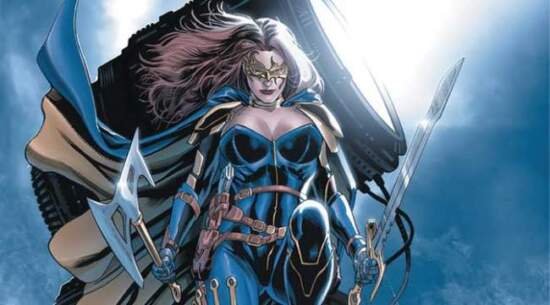Belle: Beast Hunter #1
Zenescope, January 2018
Writer: Dave Franchini
Belle: Beast Hunter is a new six-issue mini-series from American comic book publisher Zenescope. It is part of the publisher’s “Grimm’s Fairy Tales” line of titles, which provide a contemporary dark fantasy take on classic fairy tales that were collected and retold by brothers Jacob and Wilhelm Grimm under the title Kinder-und Hausmärchen in 1812.
Belle: Beast Hunter is based on the Beauty and the Beast fairy tale, but the take is very loose and does not borrow anything more substantial from the source material outside of names. While Beauty and the Beast focuses on a willful, kind-hearted woman and a prince who is transformed into a beast by a curse, Zenescope’s take features a female protagonist who has descended from a long line of female monster hunters, with Candles (who is a major-domo in the original fairy tale) serving as a butler, trainer, and mission control. The concept actually feels more Buffy the Vampire Slayer (an American television show from the 1990s) than Beauty and the Beast.
Our review of another Zenescope title, Cinderella: Serial Killer, was negative for a number of reasons. One of those reasons is that it was heavily reliant on Zenescope’s Grimm’s Fairy Tales shared continuity. As with so many American comic book titles and their publishers’ cross-promotional strategy manifesting in labyrinthine world-building, this renders the task of reading a comic extremely inaccessible to new readers. More importantly, there was very little quality in the writing in Cinderella: Serial Killer, relying mostly on now-kitsch and cheesy 1990s grindhouse gimmicks that made the comic feel banally dated and inconsequential.
Thankfully, and without overstatement, Belle: Beast Hunter is a massive improvement when compared to Cinderella: Serial Killer. We are not regular readers of Zenescope’s other titles, so we have no idea if Belle: Beast Hunter’s story is tied in with events from other titles or whether it is a new addition to Zenescope’s roster. But, regardless, this lack of knowledge is not a hindrance. All of the details required to make sense of the story are provided within the comic, either through flashbacks or by way of dialogue between the characters.
The story is fairly straightforward. During one her routine hunts, Belle encounters monsters that are seemingly acting out of the ordinary. These monsters have started appearing in places that previously were not known for monster incursions (such as a public library – another nod to Buffy the Vampire Slayer, in that, within that television series, much of the action centred around a school library). Further, at least one of the monsters demonstrates intelligence, an assessment based on its ability to speak in rudimentary English (we perhaps churlishly note the creature does not speak rudimentary French, as envisaged in the pre-Disney legend of Beauty and the Beast). It is thereby implied that the monsters that Belle encountered in the past were not intelligent and were therefore incapable of communicating.
For a first issue, Belle: Beast Hunter #1 does its job. There is a healthy balance of action scenes and exposition via dialogue and flashbacks. The story also manages to slowly set up a mystery and caps it off with a cliffhanger ending featuring the supposed death of a major character, plus the appearance of a gigantic Lovecraftian monster.
Our praise of Belle: Beast Hunter is, upon reflection, properly characterised as encouragement. This first issue is a step up from most of the titles that fall under the publisher’s recalibrated Grimm Fairy Tales’ line. But do not be fooled by any suggestion within this critique of the existence of high quality storytelling within the title. To be clear, on the whole, the comic itself is fairly mediocre. Many of the themes present are not unique, and as stated above make the comic feel like it belongs in the 1990s where hyper-violent, gun-and-sword-wielding characters with impractical costumes run rampant. In addition, some of the references and jokes within the dialogue have very limited shelf-life.
So, we do not recommend this as an example of innovative storytelling – and to be fair, it is not meant to be. But we acknowledge that it is consistently plotted with good dialogue. On our admittedly limited survey of Zenescope’s portfolio of publications, it is one of the better titles it has issued.

